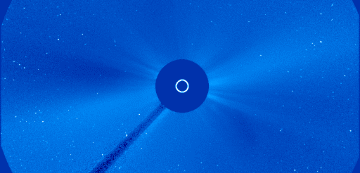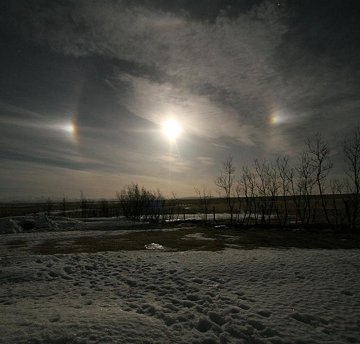| FLYBY ALERT! Would you like a phone call when the International Space Station (ISS) is about to fly over your back yard? Sign up for Space Weather PHONE. | | | THE PHYSICS OF WHIPPED CREAM: An experiment in space has shed new light on the puzzling physics of some everyday substances such as blood, ketchup, motor oil and whipped cream. Get the full sweet story from Science@NASA. SOLAR BLAST: No sunspots? No problem. Yesterday the blank sun unleashed a solar flare without the usual aid of a sunspot. At 1408 UT on April 26th, Earth-orbiting satellites detected a surge of X-rays registering B3.8 on the Richter scale of solar flares. Shortly thereafter, SOHO coronagraphs photographed a coronal mass ejection (CME) billowing away from the sun: 
The expanding cloud could deliver a glancing blow to Earth's magnetic field late on April 28th or 29th. High-latitude sky watchers should be alert for auroras when it arrives. This strange solar flare came from a patch of sun (N08,E08) where magnetic fields were not intense enough to form a visible sunspot (sunspots are made of magnetism). Nevertheless, magnetic fields were present with sufficient energy and instability to produce a powerful explosion. NASA's twin STEREO spacecraft, observing the sun from widely separated vantage points, recorded a million mph shock wave or "solar tsunami" spreading from the blast site through the sun's atmosphere: movie. Not bad for a "blank sun." Stay tuned for updates. more images: from David Strange of Branscombe, Devon, UK; from Emiel Veldhuis of Zwolle, the Netherlands; from Stephen Ames of Hodegenville, KY; from Will Gater of Bristol, UK; from Patricia Cannaerts of Belgium; from Joel Bavais of Anvaing, Belgium; MOON HALOES: When moonlight shines through icy clouds, the usual result is a simple pair of moondogs. But recently near Mt. Hekla, Iceland, photographer Agust Gudmundsson saw much more: 
"It was a spectacular night," says Gudmundsson who needed two pictures to encompass the full display: #1, #2. "I don't know the names of all the optics in the photos, but they were fantastic." Atmospheric optics expert Les Cowley identifies them for us: "This truly beautiful display has everything. A lunar parhelic circle courses through the moon and its dog companions. There is a 22 degree halo topped by an upper tangent arc. Higher still there is a rare lunar circumzenithal arc and something seen even less often: a lunar supralateral arc." For a quick-look summary, click here. "In one of the photos, there is a hole in the snow," notes Gudmundsson. "It is a snowhouse where my son Atli age 12 slept this amazing night!" Can you find it?
| 
